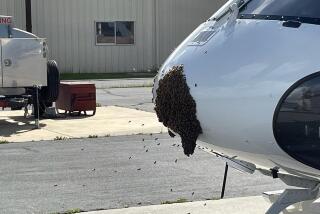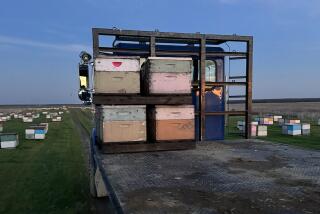Keeper Says Bees Are a Honey of a Hobby
- Share via
O'FALLON, Ill. — Jim Hendrickson isn’t sure why he keeps bees. All he says is that bees are his hobby, bees make honey, and he makes a little money.
“They’re fascinating,” he said.
A few other people in the area are fascinated with the small insects. Although honey is not a major agricultural commodity, many hobbyists are raising bees and giving or selling the honey to friends and relatives.
“There are a lot of small producers with one to two to five colonies,” said Hendrickson. “They sell a little (honey), use a lot and give some to friends.”
Most Are Hobbyists
Mike Hardimon, University of Illinois extension adviser for St. Clair County, says most county honey producers are hobbyists, although the number of hives seems to grow each year.
He said a printout listing all the county producers who had their hives inspected for pests in accordance with Illinois law had more than 200 names. One busy bee user in the county is Eckert Orchards.
The orchard rents “a whole lot of bees” for pollination of apple trees in the spring, said Larry Eckert. The orchard also buys honey from local producers for resale.
Hendrickson, vice president of the St. Clair Beekeepers Assn., said the hobby took a lot of equipment to get started, but also provided a lot of satisfaction. He said the association tries to keep a roster of 200 active, dues-paying members in the area.
Six Hives in Yard
Hendrickson’s garage is full of extractors, honey tanks, wax melters and other paraphernalia of the honey business. Six hives sit in his back yard, the maximum allowed in O’Fallon.
He worked with other beekeepers to get a city ordinance amended to allow beekeepers six hives in the city for their pollination benefits. His hives will contain anywhere from 60,000 bees on up.
A queen will lay from 2,500 to 3,000 eggs per day to keep a hive active. He re-queens, or replaces his queens, every two years.
Finding good locations for colonies away from town is getting harder and harder, he said, as much of the wild clover in the country disappears. Wild clover, dandelions and soybeans are the most important sources of nectar for bees in this area.
Interrupted by War
Hendrickson said he worked with bees in the 1940s when he was in high school. But World War II and then various jobs interrupted his hobby until about eight years ago, when he helped a neighbor who had a bee swarm in one of her trees.
It took seven weeks to get the swarm out of the tree, but it put him back in the bee business.
More to Read
Sign up for Essential California
The most important California stories and recommendations in your inbox every morning.
You may occasionally receive promotional content from the Los Angeles Times.













